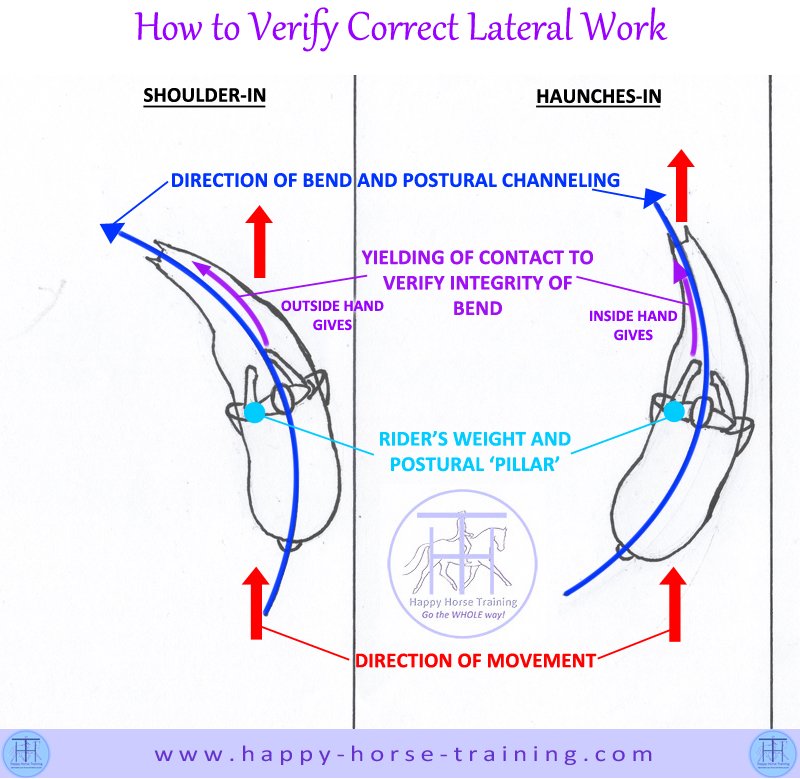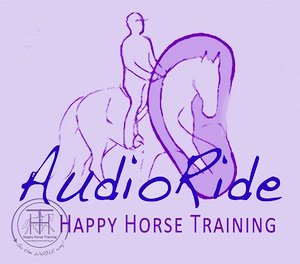How to Verify Correct Lateral Work

This diagram shows you how to check your horse is correctly balanced in lateral work, and, therefore, that this work is of gymnastic value.
An extract from 'The Gymnastic Rider' (chapter 3 'The Contact' p. 41/42):
"Yielding the outside rein is an excellent test of the quality of
bending the rider is achieving with a horse, because it tests whether
the energy from each hindleg is being successful channeled through each
side of the horse's body, via the postural support of the bend.
What often happens when the rider gives the outside rein during bending
is that the horse starts to drift laterally, either inwards or
outwards, off the desired trajectory of the bend. Which way the drifting
takes place usually depends on horse/rider crookedness, but in any case
the corrections must come from the rider's leg aiding and weight via
postural control.
If the horse drifts in when the outside rein
is yielded then more inside leg is needed and, most probably, more
weight down the inside of the rider's body to maintain the seat's
position absolutely central above the horse's spine.
If the
horse drifts the outside, then more outside leg is needed to contain the
haunches and ribcage - a horse will never fall out 'through the
shoulder' without one of these two being misaligned.
A rider
who has been used to containing the shear forces in the horse's movement
[explained earlier in the chapter] with the outside rein, may find it
very challenging to direct the horse without it, but this is because it
takes time to build up the strength and straightness required in the
horse for correct bending.
Lateral work is perhaps the most
challenging situation for yielding the outside rein. In all shoulder-in
type work, it is very common for the rider to contain and control the
sideways movement with the outside rein. When the outside rein is
yielded in shoulder-in for example, the rider may well find that either
the horse's shoulders stay stuck to the track and only the neck bends,
or that the horse turns right off the track instead of moving sideways
along it. In both cases, the real correction has nothing to do with the
outside rein, and everything to do with the rider's control of the
horse's body with the posture, weight and leg aiding.
The
verification of a truly correct shoulder in is that the rider can
completely give away the outside rein without any loss of control over
the horse's bend, angle or trajectory.
The exception to this
rule (or, rather, a permutation of it) is that in all work based on
haunches-in (e.g. haunches-in, half-pass, pirouettes) the correct bend
is actually verified by the rider's ability to yield the INSIDE rein
without loss of control of the bend and direction.
This is because
in haunches-in work, the direction of the shear forces has been reversed
by the inward positioning of the haunches, and the fact that the horse is traveling towards the inside of the bend, not away from it, so the sheer forces are now directed
towards the inside shoulder not the outside one.
The rider therefore verifies
successful channeling of the transmission straight through the horse's
body (following the alignment of the bend) by being able to give the
inside rein, which would naturally be used to contain shear forces that
hadn't been addressed. In this kind of work, the outside rein contact
remains steadily and softly connected, but without holding.
If,
when either the outside or inside rein is released, resistance comes
into the other rein where the contact is maintained, this is also a sign
of insufficient postural channeling of the energy generated by the
haunches. The rider must learn to feel where this energy is being
dissipated, and address it with seat, leg and posture, so that the
energy is transmitted through the horse's spine, creating the
characteristic softening into the contact of engagement.
We should always remember that the
real purpose and value of lateral work is to strengthen postural
channeling towards straightness and alignment, and increase the
suppleness of the joints that feeds it."
For more information about The Gymnastic Rider eBook see:
How To Ride A Horse In Balance
Go back to the Dressage Diagrams index page
Return from Verifying Lateral Work to the Happy Horse Training home
The pages on HHT are so wide-ranging and interrelated that we strongly recommend you look at the site plan to find other subjects that may interest you.
New from HHT!
AudioRide is a series of exercises designed to listen to while you ride.
Audio descriptions guide you through each step of developing a balanced, dynamic connection with the horse through your position.
This truly innovative learning tool gives you a whole new way of being guided in your riding, in a calm, clear, step-by-step way.
Free Download! Introductory Exercise: Riding in the Now
The Gymnastic Rider eBook
Now available exclusively from HHT!
A unique, comprehensive guide to practical rider biomechanics. This professionally produced eBook takes the rider through the process of developing their body in the specific way that brings the horse's movement into harmony and balance, without force and constraint. Click here for full details, and to download the 15-page introduction to the book for free.
Join the Happy Horse Training group on Facebook!
See and share topical info, news and photo's, and take part in lively discussions.
Click here to go to the HHT group (make sure you log into fb first) and then click on the 'join' button at the top of the page.
Join the Whole Horse Newsletter!
HHT's free monthly newsletter giving you wide-ranging and intelligent insights into holistic horsemanship.
Just enter your details below to join.
Free bonus on the riding position with all new subscriptions: Ten Top Tips To Instantly Improve Your Connection With Your Horse.
Click here to see back issues of The Whole Horse newsletter
Train Your Horse
The Holistic Way
How To Train A Horse Without Force
is a unique guide to training horses through energetic connection and
gymnastic training. Part 1 covers everything on the ground, from
handling to the lungeing technique that develops strength, straightness
and engagement. Comes with a free eBook supplement on Horse Trauma.
Click here for more details.
"As a student of Zen Buddhism for nearly three decades, I've often wondered when someone was going to write the book on Zen and the art of horsemanship, and I think that your emphasis on mindfulness and energy connection gets right at the heart of the matter."
- Prof. Teresa Lloyd, U.S.
Do You Have
A Horse Story
To Share On HHT?
So many people have been through
wonderful experiences with horses, whether in training or otherwise. If
you've made a change in a horse's life - or one has made a change in
yours - tell us about it here.
Learn The Natural Barefoot Trim - The Simple Way
The Simple Seven-Step Natural Trim is a comprehensive step-by-step guide to a cutting-edge barefoot trim. Click here to find out more.
What people say about HHT:
"The riding instruction is outstanding, if instructors in the UK taught this way there would be a lot of happy riders and horses."
"The riding tuition exceeded my hopes and expectations by a long way; giving me an exciting new facet to horsemanship which is lighter. more subtle, more elegant and more meaningful. It is as if a new door has opened bringing more sunlight and air."
"My goodness - what a change has taken place in my riding. I think that I'm starting to sit 'into' the horse rather than on top of him. I felt my horse's movements in a way that has almost never happened before"
Click on Testimonials for more










New! Comments
Anything to say about this page? Leave your comment in the box below.